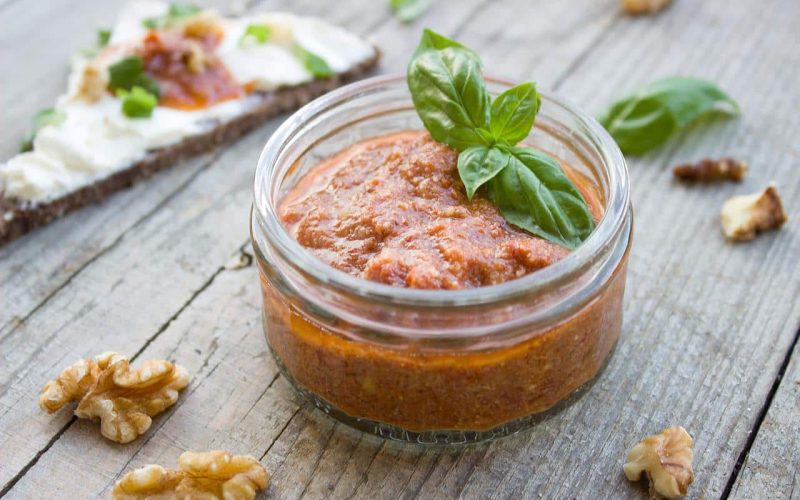Salsa holds a special place in Mexican cuisine, with roots going back to times before Spanish colonialism. Even the term “salsa” has been used for centuries, simply meaning “sauce” in Spanish. This versatile condiment has seen some changes through the years, but its fundamental elements have stayed consistent.
Whether cooked or raw, blended or chunky, made with fresh chiles or dried ones, salsa offers endless possibilities. You’ll find that most recipes fall into a few main categories, each with its unique characteristics. Explore these varieties to discover how they can enhance your cooking.
Salsa Taquera
When you think of classic salsa, salsa taquera likely comes to mind. This “taco shop sauce” starts with a simple tomato base. Chiles, most often chiles de árbol, mix with tomatoes, onion, garlic, and salt. The ingredients are usually charred or boiled before blending, enhancing their flavors.
For a twist, try adding fresh lime juice or chopped cilantro. Some recipes include a pinch of sugar or honey. This may seem unusual, but it balances the heat and acidity perfectly.
Here’s a quick list of typical ingredients in salsa taquera:
- Tomatoes: Fresh and ripe
- Chiles de árbol: For that spicy kick
- Onion: Adds a savory note
- Garlic: Enhances the overall flavor
- Salt: To taste
- Lime juice: Fresh and tangy
- Cilantro: Chopped finely
You can drizzle salsa taquera over tacos or use it as a dip for tortilla chips. It brings a burst of flavor to any dish you pair it with.
Salsa Roja
Salsa roja, or red salsa, is a flavorful and slightly spicy condiment that you often find in Mexican food restaurants. It’s similar to salsa taquera but uses only fresh chiles. There are a few variations like salsa roja asada, which is charred, and salsa Mexicana, a cooked version.
Ingredients
- Tomatoes: Fresh tomatoes are best, but canned tomatoes can work too.
- Chiles: Fresh chiles give it that signature kick.
- Garlic and Onion: Add more depth to the flavor.
- Cilantro: Offers a fresh, herbal note.
- Lime Juice: Adds acidity and brightness.
This salsa goes great with tortilla chips, but you can also use it to top tacos or mix it into canned black beans for extra flavor. When you buy jarred salsa roja at the grocery store, you’re usually getting a version of this classic salsa, often made with peak-season tomatoes to capture the best taste. Adding salsa roja to your dish brings a vibrant, fresh flavor that can enhance many different meals.
Salsa Ranchera
Salsa ranchera, known as “country sauce,” is a cooked red salsa enjoyed with chips or as a topping for dishes like enchiladas. Unlike chunky salsas, this variant offers a smooth, puréed texture due to the cooking process. This cooking also heightens acidity, making it ideal for jarring or canning, so you can easily preserve your fresh summer tomatoes.
The sauce typically includes seeded chiles and tomatoes, achieving a balanced consistency. If the salsa turns out too thick, simply thin it with a bit of water to reach your desired thickness. Use it as an enchilada sauce or a dip, depending on your meal needs.
Enjoy making and eating this versatile salsa by following these few steps:
- Roast the vegetables: Tomatoes, chiles, onions, and garlic.
- Blend until smooth: Combine the roasted vegetables to create a uniform sauce.
- Simmer: Cook the blended mixture to enhance the flavors and achieve the right acidity.
- Adjust consistency: Add water if necessary.
Whether you’re looking to preserve your summer produce or add a delicious topping to your Mexican dishes, salsa ranchera provides a flavorful, versatile option.
Salsa Criolla
Salsa criolla, also known as salsa brava, is a spicy condiment made from raw, thinly sliced red onions and habanero chiles. It’s not quite a sauce but more of a flavorful topper for various dishes. The marinade includes a tangy mix of lime juice, olive oil, and salt. Some recipes allow for swapping the chiles with other hot peppers like aji amarillo.
This salsa is a key element in Peruvian cuisine and also appears in many dishes across Central and South America. It pairs wonderfully with tacos and barbecued meats, adding a bold kick to each bite. To get the best flavor, you should let the onions marinate in the lime juice for at least 30 minutes before serving, similar to the process for ceviche.
Ingredients:
- Red onions (julienned)
- Habanero chiles (or aji amarillo)
- Lime juice
- Olive oil
- Salt
Tips:
- Make it 30 minutes ahead
- Use as a topping for tacos and grilled meats
Salsa Verde
Salsa verde is a green salsa made primarily with tomatillos, giving it a unique tangy flavor. To make it, you roast or simmer tomatillos along with serrano or jalapeño chiles, onion, and garlic until they soften. Blend these ingredients with fresh cilantro and a squeeze of lime to get that fresh, zesty taste.
You can tweak the traditional recipe by adding avocado, making it a creamy version known as salsa verde cruda. This variation keeps all ingredients raw and works great on tacos or eggs. According to experts, smaller tomatillos are less bitter and best for making this green salsa. Even purple tomatillos can be less acidic and add an interesting twist to your salsa verde.
This tomatillo salsa serves as a versatile base for many dishes like chilaquiles and enchiladas. Try it and you’ll see how it enhances almost any meal.
Salsa fresca
Pico de gallo, also known as salsa fresca, is a type of fresh, chunky salsa packed with flavor and texture. You make this vibrant salsa using tomatoes, onions, jalapeños, cilantro, and lime juice. Unlike many other salsas, pico de gallo is particularly known for its chunky and fresh taste.
You can mix it up by using different kinds of peppers if you want. Sometimes people use cucumber or pineapple to add a twist. This flexibility lets you experiment with the base ingredients to find your favorite combination.
Salsa fresca is best enjoyed fresh. The acidity from the lime makes the ingredients break down after a day, which can affect the texture and taste. It shines when added to tacos, including the delicious beer-battered fish variety, and pairs perfectly with crisp tortilla chips.
Here’s how you typically make this tasty salsa:
- Tomatoes: Firm and ripe
- Onions: Finely chopped
- Jalapeños: Adjust to your spice level
- Cilantro: Fresh and chopped
- Lime: Freshly squeezed juice
Enjoy making and eating your own salsa fresca!
Salsa Bruja
Salsa bruja, often called “witch sauce,” is like a pickle rather than a typical sauce. It mixes chiles, onions, garlic, vinegar, olive oil, and vegetables like carrots or cactus paddles. You might find yourself spooning some of the tangy pickling liquid over your tacos or other dishes, making it an interesting addition to your meal.
This sauce is also known as verduras en escabeche, which means hot pickled vegetables. The liquid used in salsa bruja can have many variations, sometimes including spices like peppercorns or allspice for a little extra kick.
Best eaten with:
- Seafood cocktails
- Crab tostadas
- Tacos
- Burritos
- Chilaquiles
You could see a container of salsa bruja at your favorite taco spot, ready to be enjoyed alongside other salsas. Its unique flavor complements many Mexican dishes, adding a zesty touch. Thanks to its pickled nature, this salsa lasts a long time if stored properly, and the flavor will get even better as it sits.
Salsa de Aguacate
Salsa de aguacate, or avocado salsa, mixes the creaminess of avocados with the tangy flavor of salsa verde. This type of salsa is different from guacamole, although they share some similarities. You can imagine this salsa as a refreshing blend where avocados take center stage.
People have enjoyed avocados since ancient times, long before the Spanish arrived. The Aztecs, for example, called it āhuacatl. Today, you’ve got plenty of ways to enjoy salsa de aguacate. It’s perfect with chips, tacos, or tlacoyos, which are oval-shaped masa snacks topped with various ingredients.
One thing to keep in mind is that this salsa doesn’t last very long. Avocados start to brown due to oxidation when exposed to air. Lime juice can slow down this process, but it’s best to savor your avocado salsa immediately after making it. Enjoy the fresh, vibrant flavors while they last!
Salsa Guajillo Chile
Salsa guajillo chile stands out due to its deep, smoky flavor and moderate heat. It centers on the use of guajillo chiles, which are one of the most popular dried chiles in Mexican cooking, just behind ancho chiles. These chiles add a unique taste to many dishes, including mole.
Making this salsa involves rehydrating the dried guajillo chiles in boiling water. This process brings out their vibrant flavor. Simple recipes often include tomatoes to give the salsa body, along with raw garlic or chopped onion for additional taste.
You can use this salsa as a dip, a topping for your tacos, or even as a base for steak or chicken marinades. For marinades, adding a bit of lime juice helps to balance the flavors with a touch of acidity. This versatile salsa brings a delightful taste of Mexico to your kitchen. For more info, check out this guajillo chile salsa recipe.
| Ingredient | Purpose |
|---|---|
| Guajillo Chiles | Main flavor component, smoky heat |
| Tomatoes | Adds body |
| Raw Garlic | Provides a sharp, aromatic flavor |
| Chopped Onion | Adds depth and texture |
| Lime Juice | Enhances acidity for marinades |
Salsa de cacahuate
Salsa de cacahuate, or peanut salsa, brings a rich and unique flavor to your dishes. The blend of peanuts with spicy chiles creates a balanced sauce that’s both tasty and versatile. The peanuts add a creamy and nutty texture, calming down the heat from the chiles.
While it might seem unusual to find peanuts in salsa, it’s actually a common ingredient in Mexican cuisine. Many traditional sauces, like mole, often incorporate ground nuts or seeds for added flavor and consistency. Even easier mole recipes sometimes use almond or peanut butter for convenience.
You can use salsa de cacahuate in various ways. It’s perfect as a dip for your chips, or you can drizzle it over your breakfast, burritos, burgers, or sizzling fajitas. Recently, some brands, like Trader Joe’s, have started selling their own versions of this delicious peanut salsa, proving its popularity and versatility in modern kitchens. Check out the recipe and give this exciting salsa a try!
Salsa molcajete roja
Salsa molcajete roja gets its vibrant flavor from roasting ingredients on a comal, which is essentially a seasoned griddle used in Mexican cooking. You’ll typically find the ingredients charred to give a smoky taste and black flecks in the salsa, adding to its unique look.
Ingredients:
- Tomatoes
- Peppers
- Garlic
- Onion
Steps:
- Roast the Ingredients: Start with tomatoes, peppers, garlic, and onions on a hot surface.
- Grind: Using a molcajete, grind the garlic first to form a paste. Continue with other ingredients until you get the desired texture.
The molcajete, a traditional mortar and pestle made from volcanic rock, plays a key role in creating this salsa. The rock’s texture helps break down and blend the components, giving you a hand-ground, chunky sauce. This salsa complements dishes like fatty carnitas or crispy taquitos perfectly, adding a punch of flavor in small amounts.
Salsa Macha
Salsa macha stands out as a unique and flavorful sauce in Mexican cuisine. Originally from Veracruz, this is more like a chile oil than a traditional salsa. The base consists of dried chiles, ground nuts, seeds, and oil. Chiles de árbol are often used, but you can switch them with other dried chiles to change the flavor.
Some recipes add dried cherries or cacao nibs, giving it an extra twist. You can create salsa macha using a molcajete or a blender. Blending the ingredients causes the sauce to separate, with solids settling at the bottom. It’s crucial to stir the mixture before using it to ensure you get a bit of everything.
Here are some ideas on how to use salsa macha:
- Drizzled over soups
- As a topping for bread
- Added to tortillas
Mixing the salsa well before spooning it ensures a balanced flavor in every bite. The oil can be spooned off the top for an extra rich and spicy finish to your dishes.
Habanero Amarilla Salsa
Habanero amarilla salsa uses super-hot yellow habanero peppers, which pack a punch. If you’re not into spice, this might not be the salsa for you. This salsa is often blended until smooth, making it more like a hot sauce than the chunky salsas you might be used to.
Ingredients to temper the heat:
- Sweet fruits: Mango is often added to balance the intense heat of habaneros.
- Other sweet components: Sometimes, other fruits or sweeteners can be included.
Color and flavor tips:
- Go for ripe, sun-yellow habaneros for the best color and flavor.
Handling habanero peppers:
- Always wear gloves to protect your skin.
- Wash your hands well after touching the peppers to avoid getting the burning heat in your eyes.
Usage tips:
- Add in small quantities due to its extreme heat.
- Use it sparingly in dishes or as a condiment for an extra spicy kick.
Habanero amarilla salsa is a fiery delight, bringing a bright, fruity spiciness to your meals.
Salsa de Chile Pasilla
Salsa de chile pasilla stands out with its unique flavor combination. The pasilla chile brings a mild heat alongside an earthy sweetness that can remind you of dried fruits and chocolate. This makes it a favorite ingredient in many Mexican dishes.
In the world of dried chile salsas, pasilla chiles are popular. You’re likely to find them in soups, sauces, and marinades. When mixing up salsa, sometimes you might go for a simple blend using rehydrated pasillas, tomatillo, garlic, and salt. Other times, you might add more ingredients like onions, lime, or cinnamon to give the salsa a more complex taste.
Even when combined with other strong flavors, the distinctive taste of the pasilla chile usually dominates. Whether you’re using it in enchilada sauce or as part of a dipping salsa, the pasilla’s unique profile always stands out.
You can explore detailed recipes and enjoy many variations of Salsa de Chile Pasilla.








